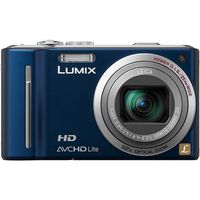Panasonic Lumix DMC-ZS7 / DMC-TZ10 Digital Camera

- Average rating of 3.5 stars from 26 reviews.
- Released 15 years 4 months ago (Mar 2010).
-770350018, 770350020, 770350019, 770350021

The Panasonic Lumix DMC-TZ10 released in March 2010 is a fourth generation TZ model and the successor to the wildly successful TZ7.
In this report for the TZ10 we look at the advancements introduced by Panasonic with this model and how it should impact your usage. We further vet Panasonic claims on the TZ10 by rounding up around 17 odd expert reviews from across some of the best digital camera review sites like CNet, CameraLabs, DPReview and LetsGoDigital.
We finally give you some buying advice on the TZ10 and a brief on how it stacks against the latest point-and-shoot lineups.
The headline feature on the TZ10 is the 12x optical zoom which comes bundled in the compact package. The lens is a LEICA DC VARIO ELMAR 25mm ultra-wide-angle and is probably the first time appearing on such small a body.
The imaging hardware comprises of a 14.5 megapixel CCD (shooting upto 12.1) backed by image processing powered by a re-engineered Venus Engine HD. HD Video support includes recording in AVCHD lite format, in addition to Motion JPEG*4. The AVCHD lite format supports almost twice the recording time over the conventional Motion JPEG.
Some of the other highlights of the TZ10 include:
1. Built-in GPS unit which is now almost mandatory for a travel targeted camera.
2. Manual control for more expressive shooting for advanced users.
3. An improved image stabilization dubbed as POWER OIS with a claimed shake suppression at twice that of the predecessor TZ7.
4. A 3-inch, 460,000 dot high resolution LCD for easier menu access.
The image quality of the ZS7 is definitely top notch for its class as rated by most of the reviewers. However, at higher ISOs the ZS7 doesn't perform as well - but this is typically expected of this range of cameras.
Most experts were pretty happy at ISO 80-100 with some noise setting in at around ISO 400. It gets worse by ISO 800 and at ISO 1600 the noise is pretty noticeable with reduced sharpness levels. The low-light pictures also don't fare too well with CNet reporting the results as 'disappointing'.
Most experts rated the video and audio quality as pretty good for the ZS7. However there were some reports on bad video artifacts at not so favourable lighting conditions. CNet reported noise when shooting in low light condition and CameraLabs reported vertical streaks in high-contrast situations. Still the overall sentiment about video capabilities was mostly positive.
The Image Stabilization was routinely praised by almost all reviewers. The shake reduction capability is certified to be very effective by most reviewers. The lens motion is pretty smooth and fast and ably assisted by the AF-assist. Experts at Digital Photography Interface found the low light focusing to be also pretty accurate, albeit a bit slow and even iTechTalk reported a tad too high for comfort shutter lag. Despite these hiccups the lens was routinely praised and none of the experts reported any barrel or spherical distortions at either end of the zoom.
The interface and handling for the ZS7 has been pretty well received by most reviewers. The menus are easy to use and intuitive, the LCD large and clear and the body pretty solid and good on the hands. There were some minor reports of reflection in bright sun light but that is which is very hard to get completely perfect at the camera range we are looking at.
The battery life also looks pretty good on the ZS7 according to the experts. CameraLabs reports it to be good for 340 shots a charge (with GPS enabled) which should be good enough to set you up for a couple of days.
The Panasonic claims with the TZ10 mostly passed with the reviewers. The image stabilization in particular received high praise and was found to be very effective by the experts.
The Panasonic DMC TZ10 is definitely a very compelling point-and-shoot in the market and combines impressive images, good video, easy to use interface in a handy package with pretty good battery life. Higher ISO performance is the only thing lacking, but should be par for the course at this price point.
The key selling point of the TZ10 (ZS7) is the super zoom packed into such a small package. This value proposition to travellers is further accentuated by the presence of the built-in GPS capabilities.
Though, for a slightly better ISO performance but a slightly not-so-good video quality check out the Fuji F300EXR.
© 2025 ReviewGist.com. All Rights Reserved.
Panasonic Lumix DMC-ZS7 / DMC-TZ10 Digital Camera